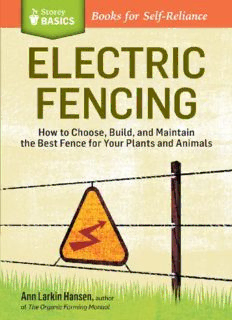
Electric Fencing: How to Choose, Build, and Maintain the Best Fence for Your Plants and Animals. A Storey Basics Title PDF
Preview Electric Fencing: How to Choose, Build, and Maintain the Best Fence for Your Plants and Animals. A Storey Basics Title
Contents Cover Title Page Contents Acknowledgments Introduction Chapter One: How an Electric Fence Works Chapter Two: The Fence Energizer Chapter Three: Fitting the Fence to the Animal Chapter Four: Permanent Electric Fence Chapter Five: Temporary Electric Fence Chapter Six: Planning and Building Your Fence Chapter Seven: Rotational Grazing Chapter Eight: Maintenance, Troubleshooting & Repairs Resources Other Storey Titles Copyright ACKNOWLEDGMENTS Although I have used electric fencing for more than 20 years, many technical details would still elude me if not for the patient and detailed explanations given me by Byron Arnold, Product Manager with Gallagher Group Limited in New Zealand, and Gordon Shelangoski, in Product Development at Premier1. Many thanks! I’m also grateful to Lacy Weimer with Kencove Fence Supplies, who helped clarify the definitions and relationships of joules and volts, and to electrician Chad Robinson with Dairyland Power, who took the time to explain currents and impedance when he was supposed to be out deer hunting. Lastly, thanks to Deb Burns at Storey, who conceived the idea for this book and guided it through to completion. — ALH Introduction The need to protect crops from hungry wildlife is as old as farming. The knowledge that moving livestock to new pastures improves their diet is as old as ranching. What’s less than a century old is getting these jobs done by putting electricity on fence wires. Around 75 years ago, the tools and techniques for portable electric fencing were developed, and agriculture hasn’t been the same since. Modern electric fencing is one of the most versatile and cost- effective tools available to the sustainable farmer who needs to contain domestic animals or protect plantings, poultry, and livestock from wild animals. For a fairly small investment (as farm equipment and supplies go) you can build and use electric fence for many different purposes, such as separating deer from seedling trees, rabbits from garden lettuce, weaned calves from cows, bears from beehives, or foxes from chickens. Where electric fence has really revolutionized sustainable agriculture is in making rotational grazing (a.k.a. management intensive grazing, or MIG) easy as well as flexible enough to adjust quickly to changing weather and seasons. Portable electric fencing used for rotational grazing will increase the carrying capacity of your pastures, improve the quality of your soils, enhance the overall ecological health of your land, and improve your farm’s bottom line. Considerations in Choosing Fencing Which components to buy and the type of electric fence to build are determined by: Species and ages of animals to be controlled Range of soil moisture conditions Amount of land to be fenced, as measured in length of fence times number of wires Whether the fence will be permanent or temporary Your budget Electric net fencing is the portable fence of choice for ABOVE: sheep, goats, and poultry on smaller acreages. Why Electric? Whether permanent or temporary, electric fencing has advantages and disadvantages compared to nonelectric, traditional fencing (see page 4). The most obvious difference between the two is that traditional nonelectric fencing — whether made of wood or wire — provides a physical barrier, while electric fencing presents a
Description: